
Linz is the third-largest city of Austria and capital of the state of Upper Austria. It is in the north centre of Austria, approximately 30 kilometres south of the Czech border, on both sides of the River Danube. The population of the city is 204,846, and that of the Greater Linz conurbation is about 789,811.

A media player is a computer program/software for playing multimedia files like audios, videos, movies and music. Media players commonly display standard media control icons known from physical devices such as tape recorders and CD players, such as play, pause, fastforward, backforward, and stop buttons. In addition, they generally have progress bars to locate the current position in the duration of the media file.
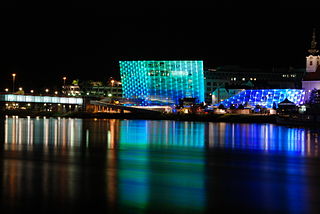
The Ars Electronica Center (AEC) is a center for electronic arts run by Ars Electronica situated in Linz, Austria, at the northern side of the Danube opposite the city hall of Linz. It has been built on the right side of the Nibelungenbrücke.

Electronic art is a form of art that makes use of electronic media. More broadly, it refers to technology and/or electronic media. It is related to information art, new media art, video art, digital art, interactive art, internet art, and electronic music. It is considered an outgrowth of conceptual art and systems art.
Manfred Mohr is a digital art pioneer. He has lived and worked in New York since 1981.
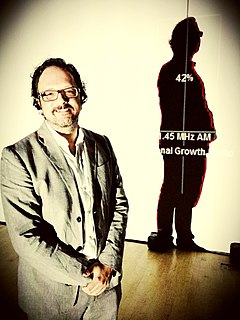
Rafael Lozano-Hemmer is a Mexican-Canadian electronic artist who works with ideas from architecture, technological theater and performance. He holds a Bachelor of Science in physical chemistry from Concordia University in Montreal. Currently, Lozano-Hemmer lives and works in Montreal and Madrid.
Alejandro Viñao is an Argentinian composer currently living in the United Kingdom.

David Rokeby is an artist who has been making works of electronic, video and installation art since 1982. He lives with his wife, pianist Eve Egoyan, and daughter in Toronto, Ontario, Canada.
David Chesworth is an Australian-based interdisciplinary artist and composer. Known for his experimental, and at times minimalist music, he has worked in post-punk groups, electronic music, contemporary ensembles, theatre, experimental opera. Together with Sonia Leber, Chesworth has created a series of large scale installation and video artworks. Exhibitions include Venice Biennale (2015), Sydney Biennale (2014).
Roy Ascott is a British artist, who works with cybernetics and telematics, on an art which is technoetic, focusing on the impact of digital and telecommunications networks on consciousness.

Maurice Benayoun is a French pioneer, contemporary new-media artist, curator and theorist based in Paris and Hong Kong. His work employs various media, including video, immersive virtual reality, the Web, performance, EEG, 3D Printing, large-scale urban media art installations and interactive exhibitions. Often conceptual, Maurice Benayoun's work constitutes a critical investigation of the mutations in the contemporary society induced by the emerging or recently adopted technologies.
Vanalyne Green is an American artist who also teaches and writes about culture. She has screened her video work extensively in the United States and abroad, including The Whitney Biennial (1991), American Film Institute, Rotterdam International Film Festival, the Videotheque de Paris, The Robert Flaherty Film Seminar, The Guggenheim Museum and many other museums, universities and film festivals. She has received a Guggenheim Foundation fellowship, as well as grants from Creative Capital, the Jerome Foundation, the Richard H. Driehaus Foundation (2003), the National Endowment for the Arts, the New York State Council of the Arts, and a Rome Prize at the American Academy in Rome (2001–2002). Her work has been covered in the Village Voice, the Los Angeles Weekly, The Chicago Reader, and Artforum. Publications by and about, and interviews with, Green also can be found in "Performance Artists Talking in the Eighties" by Linda M. Montano, "Women of Vision" by Alexandra Juhasz, in addition to M/E/A/N/I/N/G: An Anthology of Artists' Writings, Theory, and Criticism. Green's videotape "A Spy in the House that Ruth Built" was listed as one of the 1,000 best films ever made by film critic and author Jonathan Rosenbaum.

Mary Flanagan is an artist, author, educator, and designer. She pioneered the field of game research with her ideas on critical play. She has written five scholarly books and has over fifty articles to her credit. She is known for being the founding director of the research laboratory and design studio Tiltfactor Lab and the CEO of the board game company Resonym. She is also a renowned digital artist whose work has been shown around the world and has won several awards and distinctions, including the Award of Distinction at Prix Ars Electronica in 2018.
Niconico is a Japanese video sharing service on the web. "Niconico" or "nikoniko" is the Japanese ideophone for smiling. As of September 2015, Niconico is the tenth most visited website in Japan according to Alexa traffic rankings. The site won the Japanese Good Design Award in 2007, and an Honorary Mention of the Digital Communities category at Prix Ars Electronica 2008.
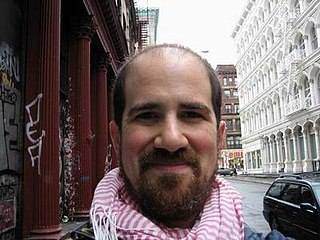
Zachary Lieberman is an American new media artist, designer, computer programmer, and educator.

The TeleGarden was a telerobotic community garden for the Internet. Starting in the mid-1990s, it allowed users to view, plant and take care of a small garden, using an Adept-1 industrial robotic arm controlled online.
Etsuko Yakushimaru is a Japanese singer, producer, composer, lyricist, arranger and artist. She is broadly active, from pop music to experimental music and art. Consistently independent in her wide-ranging activities, which also include drawing, installation art, media art, poetry and other literature, and recitation, she also produces numerous projects and artists, including her band, Sōtaisei Riron. While appearing in the music charts with many hit songs, she has also created a project that involved the use of satellite, biological data and biotechnology, a song-generating robot powered by artificial intelligence and her own voice, an independently-developed VR system, and original electronic musical instruments. Major recent activities include exhibitions at Mori Art Museum, Toyota Municipal Museum of Art, KENPOKU ART 2016, and Yamaguchi Center for Arts and Media [YCAM]. Her Tensei Jingle and Flying Tentacles albums, both released in 2016, received praise from figures including Ryuichi Sakamoto, Jeff Mills, Fennesz, Penguin Cafe, Kiyoshi Kurosawa and Toh EnJoe. She is known for her solo works including theme songs in several anime series, such as The Tatami Galaxy, Arakawa Under The Bridge, Space Dandy, Sailor Moon Crystal, Hi Score Girl, Eureka Seven and Mawaru Penguindrum. As well as being the lead vocal of the rock band Sōtaisei Riron, she also works as a contemporary artist, illustrator and narrator. She also goes by the alias of Tica α (ティカ・α) when credited for lyrics and composing. In 2017 she won the STARTS Prize for Artistic Exploration for converting her pop song I’m Humanity into DNA.
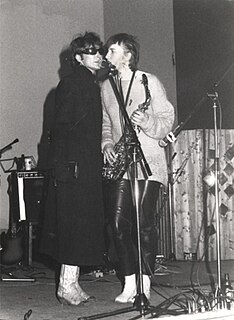
Arleen Schloss is a noted "North American performance art pioneer, video/film artist, sound poet, director and curator" who is an influential figure in the Downtown New York art, video, performance art and music scenes. Schloss began her influence through A’s – an interdisciplinary loft space that became a hub for music, exhibitions, performance art, films and videos. A hotbed of experimentation, A’s featured works from Eric Bogosian, Glenn Branca, Jean-Michel Basquiat, John Zorn, Elliott Sharp, Richard Hambleton, Liquid Liquid, Carolee Schneemann, The Coachmen, Kim Gordon, Phoebe Legere, Mania D, Thurston Moore, Shirin Neshat, Lee Ranaldo, Sur Rodney Sur, Alan Vega and Ai Weiwei. In the 1990s A's became A's Wave where website works and other forms of digital media were shown.

Ars Electronica Linz GmbH is an Austrian cultural, educational and scientific institute active in the field of new media art, founded in Linz in 1979. It is based at the Ars Electronica Center, which houses the Museum of the Future, in the city of Linz. Ars Electronica’s activities focus on the interlinkages between art, technology and society. It runs an annual festival, and manages a multidisciplinary media arts R&D facility known as the Futurelab. It also confers the Prix Ars Electronica awards.
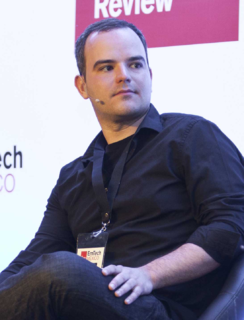
Marcelo Coelho is a Brazilian computation artist and designer. His work focuses on the boundaries between matter and computation, and includes interactive installations, photography, wearables, and robotics. Coelho is currently a Research Affiliate at the MIT Media Lab and creative director at Marcelo Coelho Studio, an anti-disciplinary studio dedicated to technically innovative and experimental work based in Boston, MA.















